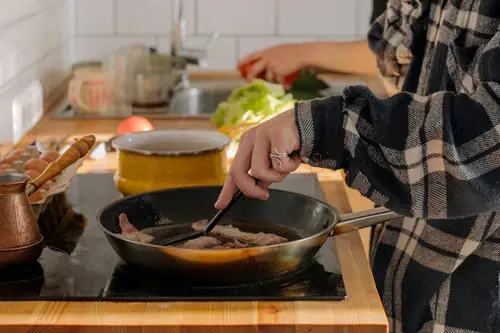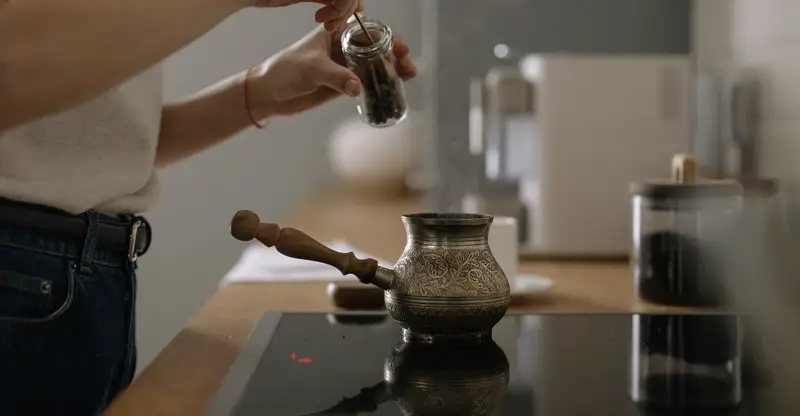Your induction cooktop is out of the box; you're ready and excited to cook something delicious. On goes your favorite saucepan with a pasta sauce that ... doesn’t seem to heat up at all.
One quick look through your kitchen cabinets, and you’re suddenly wondering if you have any cookware that will work.
Induction-ready cookware means pots and pans that will work on an induction cooktop.
When it comes to cooking with induction, not all pots and pans will be up for the job. There is a good reason for this and it has a lot to do with the way these kinds of stovetops work. Read on to learn all about it!
How Does an Induction Stovetop Cook Food?
These appliances don’t work the same way as an electric range or a gas stove. A copper wire placed underneath the cooktop burners generates electromagnetic current. The coil reacts to the pan placed on the surface to heat your food.
Yes, the cooktop surface will never get hot and it’s the magnetic field that does the heating up for you.
While these are energy efficient, cook faster, and are safer to use, they need the right kind of cookware. Without the utensil touching the surface, there is no heat generated, and these remain fancy looking glass top pieces.
The induction cooktop requires utensils that have magnetic properties, especially at the bottom. If you’ve noticed, some stainless cookware come with a special bottom with neatly placed circular ridges. They serve a specific purpose — allow the cookware and the burner to establish a connection.
What Does Induction-Ready Mean?
Gone are the days when you had to hunt for special cookware for your induction stove.
With induction cooking becoming more popular at home, compatible utensils are increasingly commonplace.
Additionally, you can still use a lot of traditional cookware to cook on induction. We’ll be discussing how a little later.
Induction-Ready Mark
Manufacturers of induction-friendly cookware display a particular symbol — the “Induction Ready” symbol.

If you’re in the market for new utensils for your brand-new stove top, look out for this coiled symbol. You can buy any such vessel without worrying about its effectiveness.
Induction-Friendly Materials
Many types of cookware are made with induction friendly materials and you may not even realize it.
Most utensils are made from two types of materials (and we aren’t talking about the metal or nonmetal aspect here). What matters for induction purposes is whether the exterior or bottom material is ferromagnetic or ferrous.
Ferrous cookware automatically has a layer or disk with magnetic properties. This allows the connection between burners and the pan or wok.
So far, we have seen cookware that are induction ready if:
- It comes with the induction-ready symbol
- It comes with a magnetic induction-friendly bottom
But what about utensils that are regularly used by home cooks?
Let’s find which of these materials are induction-compatible and which ones are not.
Related: Can You Use Ceramic Cookware on Glass Top Stoves? [Short Answer & Pros Cons Lists!]
Cast Iron Cookware and Induction Hobs
Cast iron is definitely back in fashion. Iron is a ferrous aka magnetic material. As cast iron obviously contains iron, you can use it for induction style cooking; this is true of both bare and enameled cast iron.
If you’re wondering whether you should stick to regular cast iron or buy the enameled ones, I’d say, choose the one you like the look of best because both work equally well. As the bottom is thick, there is no fear of warping either.
Of course, you have to be careful when you place cast iron products on a glass top to prevent surface damage.
You have a variety of cookware from the budget-friendly Calphalon skillet to the premier Creuset frying pan. We’re also partial to the budget-friendly yet durable Lodge induction-safe cookware.
See also: Can You Use A Cast Iron on A Ceramic Glass Cooktop?
Induction Cooking with Stainless Steel

While some stainless-steel cookware (the newer models) is induction ready, not all are well-suited.
As you’ve noticed a magnetic base is necessary for induction cookware. While iron is a key component in stainless steel pans, sometimes, nickel is mixed in or the pots come with different bottoms and cores.
This makes mixed metal cookware unsuited to these cooktops. Make sure the pot is made from 18/10 stainless steel only in the interior (to prevent rusting) but with a nickel-free base.
Always check for the coiled sign, read the seller’s description, or look for a magnetic base before you buy.
If you’re looking for induction-ready woks in stainless steel, you have a varied selection available from budget-friendly Duxtop to All-Clad luxe.
Induction Hobs and Non-Stick Cookware
Non-stick pans make cooking so much easier, don’t they?
No scrubbing to remove stuck or burnt food, and you can cut down on cooking fats.
And the best part is that plenty of this cookware is specifically designed to be induction-friendly.
Then again, there could be traces of aluminum or other non-ferrous material which renders them useless on an induction surface.
As with stainless steel, check the product labels, description, or look out for magnetic bottoms like this Utopia frying pan.
Any Other Induction Cookware Options?
You have cookware made with hard-anodized aluminum, carbon steel, and copper. Granite rock and ceramic-coated pans on the other hand need a magnetic base.
Now that you know all about induction-ready cookware, how about some tips on using hot pans on a glass stovetop?
Non-Induction Cookware
Some materials don’t conduct heat through electromagnetism, in other words, they are non-ferrous. Try as you might, the burners won’t recognize such utensils.
Aluminum, silicone, and glass are non-reactive cookware. Even non-stick and stainless steel with nickel, chromium or aluminum elements won’t work with a new hob.
So, what should you do with your old pots and pans?
Before pitching them, first test whether they are suitable for induction surfaces.
The Magnet Test for Induction Ready Cookware
If your skillet or saucepan doesn’t have a magnetic disc at the bottom, or the coiled symbol, then there is a simple way/tool to test it.
What’s that magical tool, you ask?
The humble magnet.
Use the fridge magnet or your kid’s magnets. Touch the bottom of the utensil with the magnet. If it clings to your pan, congratulations are in order — you already own induction-ready cookware.
If the magnet wobbles, then your favorite pan has a weak magnetic property.
If the magnet falls off, you can’t use it on this hob (at least not yet).
After you’re done cooking with your induction friendly cookware, it’s time to clean up your hob with these easy tips.
Special Induction Tool for Cooking
While you can use certain regular or special magnetized cookware on your induction burners, you don’t have to host a garage sale for the rest.
Three are some innovative kitchen tools in the market that bridge the gap.
These interface discs are stainless steel. All you have to do is place this between the burner and your non-ferrous pan. The disc acts as a magnetic surface and heats up your pan, and the food in it, by extension.
But, these heat diffuser induction plates come with a con. The food takes more time to cook than with induction cookware.
Final Thoughts
There are many cookware options available — making it challenging to find the perfect match for your induction cooktop.
Some are magnetic (or have magnetic bases) which allows you to cook on an induction hob. Others need an induction plate or interface to make your old utensil work for you.
If you’re not willing to get new cookware, do the magnet test to find whether your cookware is induction ready or not.
If you are ready for new cookware, check out: Top 7 Best Cookware For Induction Glass Top Stove

